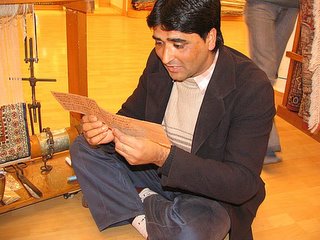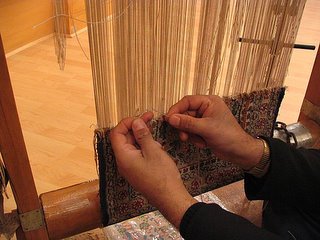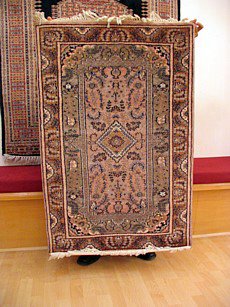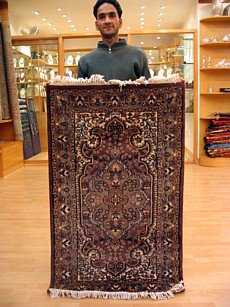I arrived in India with one major goal, beyond the obvious ones of picking up little Hope to bring her home, and just generally to see a bit of the country. I really felt it would be foolish to travel all the way to India and not take advantage of the opportunity to purchase one of these precious, durable, beautiful treasures so much more cheaply than is possible here at home, even though a large rug over there still constitutes a major purchase ... at least for our budget!
During our time in Delhi, we made several trips trying to find the shop that Nanette remembered from her previous trip. Unfortunately, we never did, but we did come upon a wonderful shop run or subsidized --- I wasn't totally clear --- by the Indian government to benefit the various craftspeople throughout the country. Actually, we came across several, but the one in this story is where I ended up purchasing several 3' x 5' rugs for Christmas presents. They cost more than I would normally spend for a Christmas present, but again, I refer you to paragraph 1!
The concierge at our hotel is friends with a man who manages one of these stores, known as Cottage Industries stores. The friend, Rajiv, actually came to the hotel to drive us to the store. It was near the end of our trip, and we still hadn't found the right place to buy carpets, and we were wondering if we would go home disappointed. By then we had little Hope with us, who was beginning to twig to the fact that every time we left home in a car we were going shopping. So far, she hadn't quite gotten in the spirit of things; in fact, she was beginning to act the same way Simba does when he realizes the car trip is going to end up at the vet's. So, we didn't have unlimited time to hang out and schmooze in the stores.
Rajiv, bless him, took us straight to the carpets and turned us over to Sajjad, a young married man with a brand new son at home. "Home" is the Indian section of Kashmir. Evidently, there's not much industry there (as can be imagined, considering its uncertain political future and the number of tanks and machine guns in the area), so he has had to come to Delhi to earn a living. Nonetheless, he has a wonderful cheerful spirit about him, and we grew quite fond of him over the hour or so we spent at the store.
The process goes something like this:
"What size carpets are you looking for, madam?" (Yes, they called me madam)
"3 x 5"
"We have some lovely carpets in that size, madam, but are you sure you wouldn't care for this carpet since they are so inexpensive?"
"No, these are gifts, and I wouldn't care to give them a large carpet as I'm not sure where they will have space for the carpet. Just 3 by 5, please."
"Yes, madam. First we would like to show you how Kashmiri carpets are made. Will you come sit over here?"
I'm sure I could have moved them straight to the sales process, but I was very interested to hear how human beings could possibly produce such perfect, beautiful, sturdy carpets by hand. I knew that the back of the carpet would be a perfect replica of the front, but how the heck do they do that??
So, here's what I heard about how carpets are made.
Kashmiri rugs are held to be among the finest in the world. 95% of the rugs sold in India are made in Kashmir. The people there are renowned the world over for their skill, and the climate provides the perfect humidity for rug making. This rug came from the Indian side of Kashmir. Fortunately, the recent earthquake in Pakistan did not affect the people there.
Following are some pictures that depict how a rug is created using these ancient methods.
 When a pattern is created, it is hand-drawn on several large sheets of paper, which are then laminated and used over & over. Creation of a new pattern takes five to eight years. Each family makes carpets from only one or two patterns, right down through the generations. Thus, a person who is knowledgeable about hand-made carpets in India can see the carpet and know immediately the names of the family who made it.
When a pattern is created, it is hand-drawn on several large sheets of paper, which are then laminated and used over & over. Creation of a new pattern takes five to eight years. Each family makes carpets from only one or two patterns, right down through the generations. Thus, a person who is knowledgeable about hand-made carpets in India can see the carpet and know immediately the names of the family who made it. The pattern is then translated into these sheets of code, which can only be read by trained carpet makers. Sajjad, the salesperson who assisted me in buying your rug, tells me it's similar to computer code, and can be read as "light blue, two knots."
The pattern is then translated into these sheets of code, which can only be read by trained carpet makers. Sajjad, the salesperson who assisted me in buying your rug, tells me it's similar to computer code, and can be read as "light blue, two knots." Here's a picture of Sajjad demonstrating how one person of the carpet making team is responsible for reading the code to those who are tying the yarns.
Here's a picture of Sajjad demonstrating how one person of the carpet making team is responsible for reading the code to those who are tying the yarns. This is a miniature replica of a loom. Notice the pieces of paper hanging on the left of the loom; these are the code sheets for the carpet. The loom is always worked perpendicular to the floor, unlike some other weaving looms, which are usually held parallel to the floor. There are two sets of coarse twine that form the base for the rug, which you can see running vertically on the loom. One set of twine forms the bottom of the rug, the other forms the top. In the next picture, you'll see why.
This is a miniature replica of a loom. Notice the pieces of paper hanging on the left of the loom; these are the code sheets for the carpet. The loom is always worked perpendicular to the floor, unlike some other weaving looms, which are usually held parallel to the floor. There are two sets of coarse twine that form the base for the rug, which you can see running vertically on the loom. One set of twine forms the bottom of the rug, the other forms the top. In the next picture, you'll see why.
The back of a Kashmiri rug is a perfect image of the front, without the nap of the fibers. This is accomplished by wrapping the yarn first around a top piece of twine and then around the corresponding bottom piece of twine, then bringing the loose end to the front. Click the picture to get a closer look at how this works. Notice the raggedly trimmed yarns in the most recently tied couple of rows.
 These are the tools used in making a rug. The one on the left is a sort of machete, with the cutting edge on the interior of the curve. It is used to cut each yarn as it is tied. The one on the right is a sort of comb that is used to press the recently tied yarns tightly down against previous rows. The shears are used to cut the yarns evenly so the rug has a smooth, even surface.
These are the tools used in making a rug. The one on the left is a sort of machete, with the cutting edge on the interior of the curve. It is used to cut each yarn as it is tied. The one on the right is a sort of comb that is used to press the recently tied yarns tightly down against previous rows. The shears are used to cut the yarns evenly so the rug has a smooth, even surface.By the time the rug is complete, it has been hanging on the loom for months or even years.After the edges are finished and fringes added, it is taken down from the loom and put through several clear water washes. For protection from moths, one of the rinses has some onion paste added to it.
That's the process!
I’m told that these rugs can be expected to last for generations. Heavy furniture does them no harm: when you remove the furniture, you’ll see the imprint for a week or two, but after a couple of weeks the fibers will have sprung right back. These carpets actually improve from being walked on, because doing so releases the lanolin in the wool. They can be cleaned by shaking them or vacuuming them. If they need to be washed just sprinkle some cool water on them and use a brush. If they need spot cleaning, just cut a lemon in half and rub it over the stain. The dyes are reputed to be colorfast and should not run. But you can also take them to a reputable carpet cleaner who is experienced in working with “oriental” rugs.
After we were oriented to the rugmaking process, we went through a great session of having two other men in the store bringing out carpet after carpet for our review, as we sat drinking tea and shaking our heads "no" or "maybe". The no's were pulled aside and thrown in a great heap. The maybes were accumulated until we had 6 or 8 of them, and then they would ask us to eliminate a few. Onto the heap they went. Finally, we ended up with the 4 carpets, which were sewn into amazingly compact burlap bags and labeled so I could remember which was which. I carried these home on the plane with me. (The larger one that I bought for my home was shipped, and came within 3 weeks of purchase.)
So, here are pictures of the ones I ended up purchasing.




As I waited for the rugs to be wrapped, I spent some time talking with Sajjad. His pride in his country, Kashmir, is so evident. He told me that before it became a disputed territory between India and Pakistan, it was a tourist destination, famous for a hotel that floated on one of the clear cold lakes in the mountains. There are beautiful mountain lakes, and his house is on one of them. He misses his wife and son, of course, and showed me pictures of them. And, to my delight, he insisted that if T and I ever come back to India, he would be delighted to have us come stay with him and his family, using their house as a base to explore his beloved country. How kind is that? These people are so hospitable. We don't even know the meaning of the word, compared to them.
The final, delightful event took place as Rajiv was driving us back to the hotel. The shop was some distance away, so we were discussing his life and family. He, too, lives away from his family, but December is part of their two-month school vacation period, so his wife and two children had come to live with him in his cramped quarters. He expressed a wish that he could invite us to his home, but it is just impossible. Again, I marveled at the hospitality of these people. Delhi is very expensive to live in, and he is finding it hard.
He asked whether we had seen any of the sights. We said that our time had been circumscribed by our need to do bureaucratic details for Hope's visa, and that we were leaving the day after next and would probably have to reserve sightseeing for another trip. Without another word, he took us out of the way to go see some of the more splendid sights of Delhi, the government buildings and the arch commemorating World War I. I will post pictures of those sites later, this post is already too long! When Nanette pointed out the little monkeys on top of the government buildings, he asked if we would like to see some close up. I immediately said, "Oh yes!" without considering that Hope was getting fussy in the back seat. Oops. I apologized to Nan later. Anyway, he took us to a drive-through open area where tourists were (illegally) feeding the monkeys, before finally depositing us at our hotel.
I love the Indian people. They are so giving, so kind. I'm sure they have all the character flaws that all of the rest of us do ... after all, they're human! ... but it surely is a wonderful place to visit.
11 comments:
Hi Pat,
Thank you for the wonderful welcome and for visiting my blog. Congratulations on your niece, Hope. She is beautiful.
Ahhh! Jambalaya. I haven't had that in so long. I'll have to ask around the fam for the recipe and when I get it, I'll blog it. ;)
Very nice rugs.
Could you provide the name and address of this subsidized by the Indian government rug store in new delhi.
Ben
This is my first visit to your blog, your post made, thank productive reading you. You can check kashmiri carpets online here.
Post a Comment